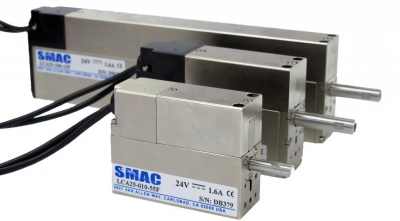
The requirement for strict specification and acceptance of all automotive parts and components has greatly increased in recent years. Screw thread inspection is no exception. The common practice of eddy current probes, lasers, proximity sensors or vision systems are only partly successful as they only inform you of the presence of a thread, not if it's correct or within tolerance. The unique low-cost SMAC solution enables you to automatically check the following screw thread parameters:
• Oversize or undersized threads
• Cross threads
• Thread depth
• No threads
• Mis-located threads
• Thread pitch
• Shallow or blocked hole
The automated thread checking solution from SMAC enables a 100 percent detailed inspection and verification of all parts. It also identifies tool wear sooner, and allows SPC data acquisition for process control and quality systems. All of this translates to higher quality and throughput, lower costs and increased customer confidence.
An optional Thread Check Graphical User Interface (GUI) is also available. Graphical User Interface, SMAC-Motion, provides a simple and straightforward way to quickly configure motion parameters of a variety of SMAC single/dual axis actuators and controllers.
Automotive industry parts and assembly quality standards have moved from sigma level sampling to zero defect requirements. These more stringent manufacturing results can be achieved through a combination of containment through 100 percent inspections (eliminating bad parts) and correction through immediate feedback and adjustment. Inspection by hand can be reduced or eliminated, parts rejection can virtually be eliminated and tool wear can be substantially reduced, all while increasing the pace of production.
SMAC programmable actuators allow 100% detailed inspection and verification for all mission critical parts and are being used in a variety of automotive applications such as screw thread checking, switch tests, quality measurement, effort testing and displacement testing. SMAC can provide unique inline quality control solutions that successfully automate inspection procedures.
Automating these processes means:
- 100 percent inspection
- Increased quality
- SPC data acquisition
- Process control feedback
- Increased throughput
The precision Z-theta motion within the LAR55 actuator provides a convenient pick, orient and place solution to screw thread checking. SMAC offer a wide variety of LAR55 linear rotary actuators with either direct drive or gearbox equipped rotary units.
A vacuum-built-in shaft through the rotary motor is available for some models to prevent dust build-up in the unit. These z-theta actuators can easily be programmed to control force/torque, position and velocity in all axes at the same time with feedback capability.
Finally, SMAC's unique, patented "Soft-Land" function enables the unit to gently land on a delicate component with a controlled force to avoid damage of both the component and the actuator.
Contact Details
Related Glossary Terms
- land
land
Part of the tool body that remains after the flutes are cut.
- pitch
pitch
1. On a saw blade, the number of teeth per inch. 2. In threading, the number of threads per inch.
- process control
process control
Method of monitoring a process. Relates to electronic hardware and instrumentation used in automated process control. See in-process gaging, inspection; SPC, statistical process control.
- quality assurance ( quality control)
quality assurance ( quality control)
Terms denoting a formal program for monitoring product quality. The denotations are the same, but QC typically connotes a more traditional postmachining inspection system, while QA implies a more comprehensive approach, with emphasis on “total quality,” broad quality principles, statistical process control and other statistical methods.
- statistical process control ( SPC)
statistical process control ( SPC)
Statistical techniques to measure and analyze the extent to which a process deviates from a set standard.
- tolerance
tolerance
Minimum and maximum amount a workpiece dimension is allowed to vary from a set standard and still be acceptable.






